
CCC: UK will miss climate goals by ‘huge margin’ without new policies
Josh Gabbatiss
06.24.21Josh Gabbatiss
24.06.2021 | 12:01amThe UK government has once again failed to come forward with sufficient policies to meet the ambition of its climate goals, according to the Climate Change Committee (CCC).
Across nearly 500 pages examining the government’s net-zero and adaptation targets, the climate advisers spell out the gap between aspirations and reality in a pair of new reports.
Only four of 21 key decarbonisation areas outlined in the report have seen sufficient ambition and only two have adequate policies in place for cutting emissions, according to the CCC. None of the 34 adaptation priority areas it identifies have seen strong progress.
The committee says it is “disappointing” that many “vital and long-promised plans”, concerning everything from clean transport to hydrogen, have yet to emerge.
With the UK preparing to host the COP26 summit in Glasgow, the CCC warns that the government’s backlog – which includes an overarching plan for achieving its net-zero emissions target – could harm its credibility and push its climate goals out of reach.
The UK’s climate ‘policy gap’
The committee has released two progress reports simultaneously, as part of its statutory duties under the UK’s Climate Change Act.
The first report focuses on efforts to reduce emissions in line with the UK’s legally binding five-yearly carbon budgets, which set out the path to its target of net-zero emissions by 2050.
This document draws extensively on the CCC’s proposed pathway for achieving the “sixth carbon budget” for 2033-37, a “stepping stone” of emissions cuts on the way to net-zero. The budget was voted into law only two days before the report’s release.
It also comes a year after another CCC progress report that similarly warned of insufficient action from the government on tackling climate change.
The second report assesses progress on climate adaptation. While it has been two years since such a report was published, the new one comes shortly after a risk assessment from the committee that warned adaptation was being “underfunded and ignored”.
UK emissions dropped by a record 13% last year, from 499m tonnes of carbon dioxide equivalent (MtCO2e) in 2019 to 435 MtCO2e, according to the committee.
This is larger than the 9% drop reported by the government because it includes CCC estimates of the UK’s share of international aviation and shipping emissions. For the first time, the government intends to include these emissions in its sixth carbon budget, but they do not yet appear in its official emissions data.
(Another change to the way the government assesses emissions has already come, with the latest greenhouse gas inventory figures including updated estimates from UK peatlands. This was accounted for by the CCC in its sixth carbon budget advice and the committee notes that more changes to the inventory are expected in the coming years.)
Although the committee states that emissions are now “nearly 50%” below 1990 levels – the baseline for UK climate targets – it emphasises that “the journey to net-zero is far from half done”.
It notes that the majority of emissions cuts so far have come from a rapidly decarbonising power sector, which saw emissions fall 65% from 2009 to 2019.
“If progress does not extend outside the power sector, the sixth carbon budget will be missed by a huge margin,” it states.
The policies in place so far will only cut – at most – a fifth of the emissions required to hit the sixth carbon budget in 2035, the CCC says.
Even expanding this to “ambitions” announced by the government but not yet enacted in firm policy only covers around half of the necessary emissions cuts.
This “policy gap” is not unique to the sixth carbon budget, as government projections suggest the UK is not on track to achieve its fourth or fifth carbon budgets either.
This is shown by the blue line on the chart below, with the black and grey lines indicating historic emissions and the red and pink lines indicating the CCC’s pathway to net-zero. The paler colours indicate emissions value that do not include international aviation and shipping.
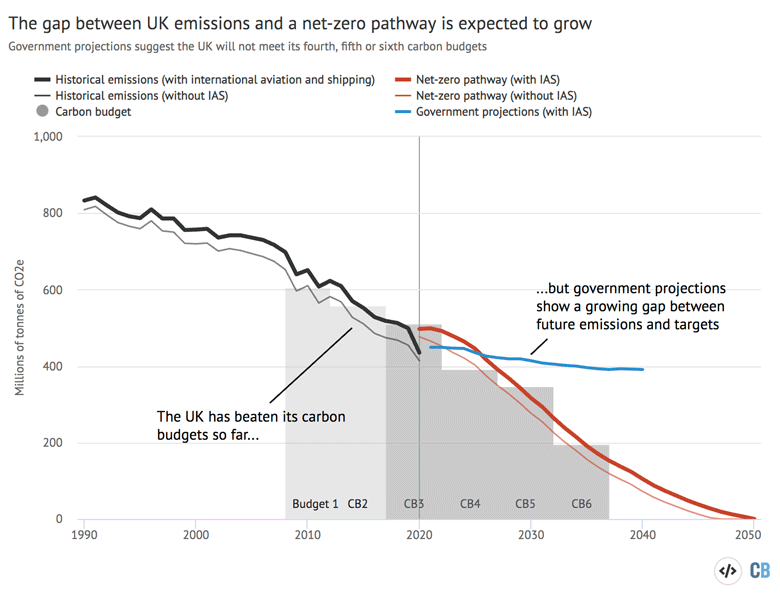
Moreover, the CCC has repeatedly warned of a policy gap between the government’s plans and its legally-binding targets in recent progress reports.
Covid-19 and consumption emissions
The record-breaking dip in emissions last year, resulting from Covid restrictions, will have “practically zero impact on the UK’s past and future contribution to global warming” and for the most part does not represent structural change, the CCC states.
As the chart below demonstrates, the vast majority of emissions cuts were the result of reduced use of road transport (dark blue bar) and particularly aviation (purple). These are expected to rebound as restrictions are lifted.
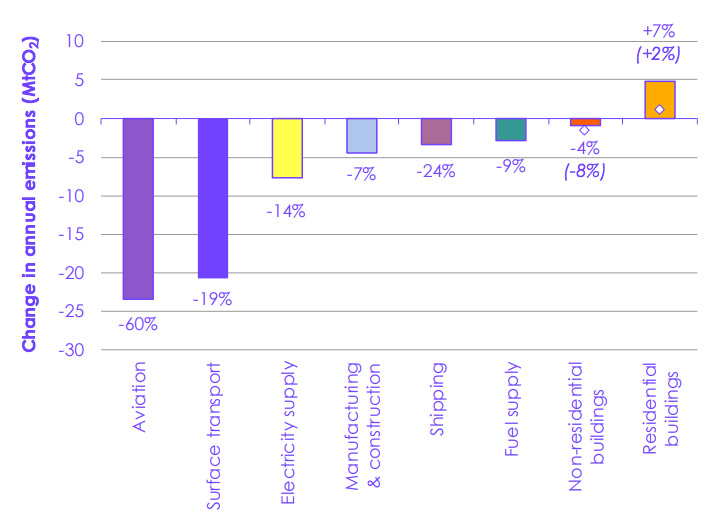
However, the committee does suggest there is a “limited window” to change people’s behaviour following the pandemic – for example, by sustaining the uptick in walking and cycling by investing in appropriate infrastructure.
The report includes some more speculative analysis that considers both short- and long-term impacts of Covid-19, including a more sustained switch to home-working.
It also devotes notable attention to “consumption emissions” created overseas to provide the foreign goods and services used by UK consumers.
While these are not the basis of emissions accounting for the UK’s targets, they are a frequent talking point for campaigners who are concerned about the country “offshoring” its emissions to other nations as it decarbonises.
The UK’s consumption emissions have fallen by 2% each year since 2009 – apart from a 1% uptick in 2018 – and there is “little evidence” of offshoring UK territorial emissions “as part of decarbonisation efforts over the last decade”, the CCC states.
How has the UK progressed on net-zero ambitions and policies?
The CCC identifies 21 “significant sources of abatement”, from zero-emissions cars to peatland restoration, where progress will need to be made to reach the UK’s goals.
It assigns each one a grade, based on the level of government ambition to cut emissions in that area and the policies that are actually in place to get the job done.
Only four have sufficient ambition and only two have sufficient policies in place to meet the sixth carbon budget, according to this analysis. What is more, 13 areas face “significant” or “major” risks of falling behind, in terms of ambition, and 18 in terms of policy.
While the categories are not directly equivalent, this tallies with last year’s assessment that found that the UK had failed on 17 out of 21 progress indicators, meeting just two of 31 key policy milestones.
Among the areas with the worst anticipated policy outcomes are energy efficiency and low carbon heat in homes, and the electrification of industry.
Chris Stark, CCC chief executive, tells Carbon Brief:
“There’s a general feeling that the government is quite keen to present itself as more ambitious, keen to sign up to ambitious long-term targets as a platform internationally, but less keen to deliver against those things with difficult policy decisions.”
This year was supposed to see an array of strategies published in quick succession that would set out the details of the government’s plans for reaching net-zero across each area of the UK economy.
Among the documents that have emerged in the past six months are the prime minister’s 10-point plan, an energy white paper, an industrial decarbonisation strategy and peat and tree plans for England.
However, strategies for transport, hydrogen, heat and buildings, as well as the Treasury’s net-zero review and the net-zero strategy itself, are yet to be released.
The CCC says that the delay of most of these reports is “disappointing and means that we have only a partial picture of ambition”.
In its sixth carbon budget advice, the committee introduced its “balanced pathway” that achieved both the budget itself and the longer term goal of net-zero emissions by 2050.
This pathway is indicated by the dashed purple line in the charts below, with the proportion of emissions cuts accounted for “fully” (green) or ”potentially” (yellow) by government ambitions (upper chart) and the policies it already has in place (lower chart).
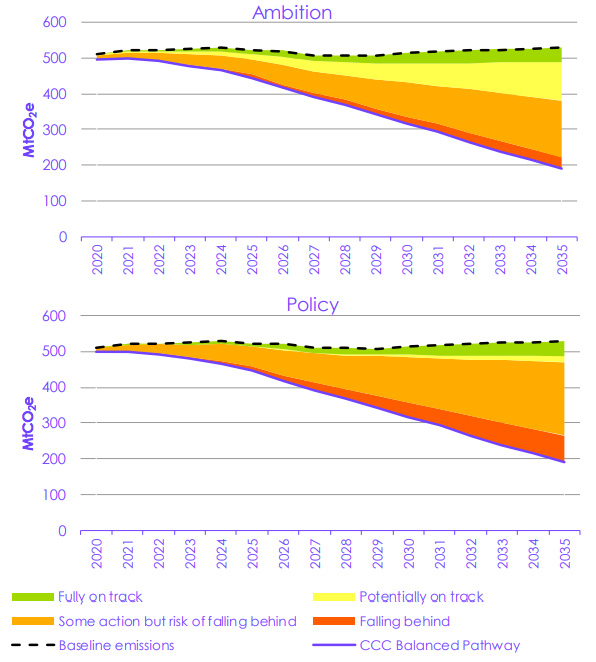
Last year’s progress report made 92 recommendations for government departments, of which just 11 have been achieved in full, with 29 partly achieved and 34 underway. These results are illustrated in the figure below.
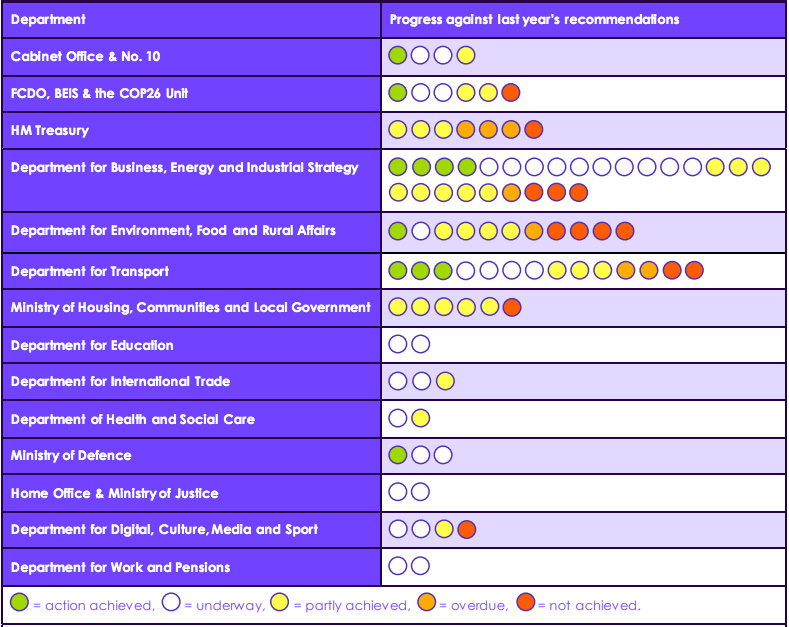
The CCC notes that some departments “are lagging behind others, and appear timid in their approach”. It points in particular to the Department for Environment, Food and Rural Affairs (Defra) and the Ministry of Housing, Communities and Local Government (MHCLG) .
An accompanying report also includes a new set of around 200 recommendations for government departments, devolved administrations, regulators and the Office for National Statistics, to help get the nation back on track.
What recommendations does the CCC make for net-zero?
While the government is not obliged to precisely follow every part of the CCC’s guidance on how to get to net-zero emissions, the committee says “it must set out a credible alternative approach where it chooses not to”.
For example, the government has pledged to reach 600,000 heat pump installations per year by 2028, rather than the 900,000 recommended by the CCC. In this and other similar areas, the CCC says the government will have to address the shortfall elsewhere.
The committee says the government’s overarching net-zero strategy will be essential to provide clarity on this. Stark tells Carbon Brief:
“We did not design in lots of slack [in our net-zero pathway]…if they’re behind on any one of the sectors in our pathway, then they have to make up for it somewhere else, and we don’t see huge opportunities to do that. So it will be really interesting to see what the government comes up with.”
Overall, the committee says “credible policies” must be up and running by the end of the current parliament in 2024 “to ensure that almost all investments and purchases are low-carbon by the end of the decade or soon after”.
The chart below demonstrates that, in several policy areas, current government plans are already way behind what has been proposed by the CCC in its net-zero pathway.
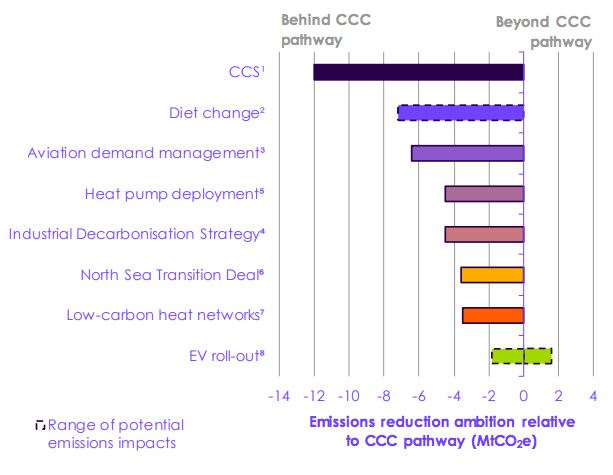
So far, the CCC says the government has focused on technologies and largely ignored what Stark refers to as policy areas deemed “politically difficult”, involving behavioural change.
Cutting demand for air travel and reducing meat and dairy consumption were the only two areas in which there had been virtually no action on either ambition or policies, according to the committee.
It identifies public engagement on these issues and an “overdue” net-zero aviation strategy – alongside other targets such as phasing out unabated gas-fired electricity generation by 2035 – as “key gaps that must be addressed”.
Other areas have been the subject of ambitious targets, such as the 2030 phase-out date for sale of petrol and diesel cars and vans, but the CCC says there remains significant ambiguity about how these targets will be translated into the real world.
In a foreword by CCC chair Lord Deben and chair of the adaptation committee Baroness Brown, they emphasise that “our planning system and other fundamental structures have not been recast to meet our legal and international climate commitments”.
In a press briefing, Lord Deben used the example of the controversial proposed coal mine in Cumbria, noting that the local county council had no guidance on net-zero.
To amend this, the committee proposes an “explicit” net-zero test as part of the government’s strategy, which could ensure all policy and planning decisions are compatible with climate goals.
Finally, the CCC criticises the government’s decision to cut UK overseas aid, which “undermines” its climate finance commitments. “Now that the UK’s economic recovery is underway, the government should provide a firm timeline for reinstating its previous commitment,” it says.
As the government shifts from setting targets to implementing them, the committee sees its role changing too. Among other things, it intends to spend more time assessing the wider aspects of decarbonisation, including non-government action and the fairness of the net-zero transition.
The cost of net-zero
Stark emphasised in the press briefing that the government needed the full support of the Treasury, but with its net-zero review – originally due in autumn 2020 – yet to be completed, the CCC chief executive said its silence was “really noticeable”.
“We’ve had procrastination from our finance and economics ministry on this, despite the promised turnaround in their thinking on climate,” he said.
The CCC has consistently emphasised the low price tag attached to net-zero, previously estimating costs of 1% of GDP and a potential economic boost of 2% of GDP within a decade. Stark tells Carbon Brief aggregate costs are “well below 1% of GDP now in our central estimates”.
However, starting with the former chancellor Philip Hammond, there has been consistent commentary within the media and among politicians about what they perceived as high costs associated with the target.
Stark emphasises the need to fill the “vacuum” left by the Treasury on this. By the CCC’s estimate, he says that meeting the net-zero target would only delay reaching the GDP level otherwise expected in 2050 by four months, even assuming a cost associated with net-zero rather than an economic boost.
He tells Carbon Brief that his concern is that the Treasury is focusing more on the costs themselves rather than the “real challenge”, which is ensuring both costs and benefits are spread fairly.
This is particularly true for decarbonising buildings and industry – homes and jobs – he says:
“If the Treasury is not stepping in to say what they are going to do about those issues, then you create a space for the bad faith actors to fill.”
Last year, Stark said he was willing to cut the government “a bit of slack” during the pandemic, but the committee also urged leaders to take the “once-in-a-lifetime” chance to invest in a “green recovery” offered by Covid-19.
In the months that followed, the government did make some big spending announcements, touting them as part of its green recovery plans.
However, not only were these pledges dwarfed by those offered by other European governments, the main stimulus package – the £2bn “green homes grant” – was cancelled after reaching just 10% of the homes it was meant to benefit.
The CCC concludes that “while fiscal pressures remain, overall UK investment continues to be low. More can be done to boost private investment and increase tax revenues while accelerating decarbonisation.”
How has the UK’s adaptation strategy progressed?
The CCC’s adaptation progress report reiterates many of the points made in its recent risk assessment, not least that the UK’s national adaptation programme has so far failed to prepare for a 2C rise in global temperatures, “let alone higher levels of warming”.
Unlike the annual mitigation progress report, the CCC is only required to produce a progress report for adaptation – covering England and non-devolved UK matters – every two years.
It comes ahead of the third iteration of the nation’s national adaptation plan, which is due in 2023. The first and second versions have both failed to deliver “a minimum level of resilience to current and inevitable climate change,” the CCC says.
The committee assessed progress on 34 adaptation priorities, including rail networks, flood recovery and agricultural productivity.
It found that planning for 2C and consideration of 4C of warming was only taking place for seven of those priorities, which can be seen in the bottom row of the figure below. No sector achieved the highest risk management score of nine (bottom left corner).
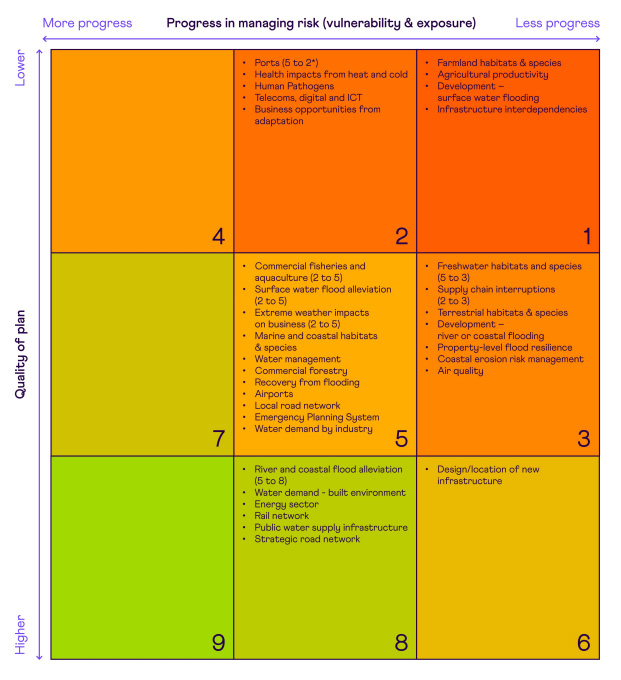
Compared to the last progress report, improved assessment scores were only given for five of the adaptation priorities: river and coastal flood alleviation, surface water flood alleviation, extreme weather impacts on business, supply chain interruptions and commercial fisheries.
As with the net-zero progress report, the adaptation document includes a list of policy recommendations aimed at government departments. Ten of these are joint recommendations that also appear in the other report.
Among these specific recommendations are targets for boosting green spaces in cities, including an overheating standard for building regulations and banning rotational burning on all peatlands from this year.
Additional overarching recommendations include reinstating support services and resourcing for local adaptation action, and responding to risks from climate change overseas. Currently, the national adaptation programme does not consider the latter issue at all.
-
CCC: UK will miss climate goals by ‘huge margin’ without new policies
-
CCC: ‘Disappointing’ lack of plans to prepare the UK for net-zero

